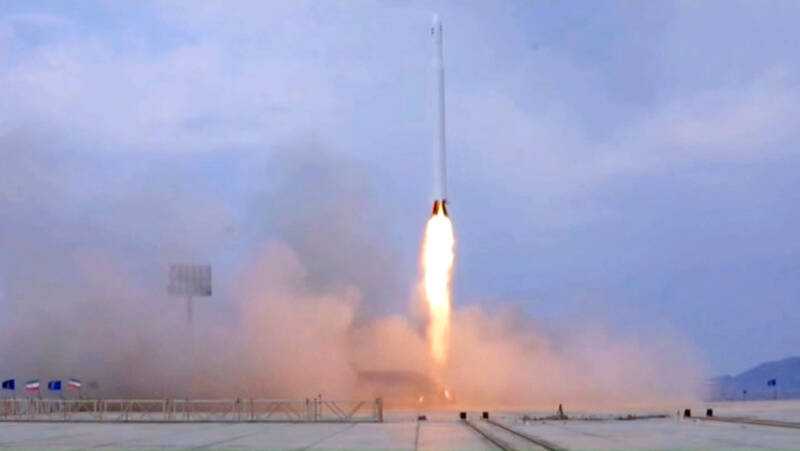The US has quietly acknowledged that Iran’s paramilitary Revolutionary Guard successfully put an imaging satellite into orbit this week in a launch that resembled others previously criticized by Washington as helping Tehran’s ballistic missile program.
The US military has not responded to repeated requests for comment from The Associated Press since Iran announced the launch of the Noor-3 satellite on Wednesday, the latest successful launch by the Revolutionary Guard after Iran’s civilian space program faced a series of failed launches in recent years.
However, early yesterday, data published by the Web site space-track.org listed a launch on Wednesday by Iran that put the Noor-3 satellite into orbit. Information for the Web site is supplied by the 18th Space Defense Squadron of the US Space Force, the newest arm of the US military.

Photo: AFP / Iran Press
It put the satellite at more than 450km above the Earth’s surface, which corresponds to Iranian state media reports regarding the launch. It also identified the rocket carrying the satellite as a Qased, a three-stage rocket fueled by both liquid and solid fuels first launched by the Guard in 2020 when it unveiled its up-to-then-secret space program.
“Noor” means “light” in Farsi, while “Qased” means “messenger.”
Authorities released a video of a rocket taking off from a mobile launcher without saying where it occurred. Details in the video earlier analyzed by the AP corresponded with a Guard base near Shahroud, about 330km northeast of Tehran. The base is in Semnan province, which hosts the Imam Khomeini Spaceport from which Iran’s civilian space program operates.
Space-track.org also listed the missile as having been launched from the Guard base at Shahroud.
Speaking on Thursday night to Iranian state television, Guard space commander General Ali Jafarabadi described the Noor-3 satellite as having “image accuracy that is two-and-a-half times that of the Noor-2 satellite.”
Noor-2, launched in March last year, remains in orbit. Noor-1, launched in 2020, fell back to Earth last year.
Jafarabadi said Noor-3 has thrusters for the first time that allow it to maneuver in orbit. He also offered a wider description of Iran’s hopes for its satellite program, including potentially controlling drones. That could raise further concerns for the West and Ukraine, which Russia has bombarded with Iranian-made bomb-carrying drones for more than a year.
“If you look at the recent wars in the world, you will see that success on the battlefield is very dependent on the use of satellite technologies,” Jafarabadi said. “Now the armed forces in all the progressive countries are trying to make all their equipment remote control, it means that to make it steerable, when a vessel or any other equipment takes a long distance from us, it is no longer possible to see and guide it, except through satellite.”
The image-taking capabilities of the Noor-3 remain unclear. International sanctions on Iran have locked it out of accessing commercially available imagery, forcing it to develop its own homegrown satellites.
The head of the US Space Command dismissed the Noor-1 as a “tumbling Web cam in space” that would not provide vital intelligence.
The US says Iran’s satellite launches defy a UN Security Council resolution and has called on Tehran to undertake no activity involving ballistic missiles capable of delivering nuclear weapons. UN sanctions related to Iran’s ballistic missile program are due to expire on Oct. 18.
The US intelligence community’s 2023 worldwide threat assessment says the development of satellite launch vehicles “shortens the timeline” for Iran to develop an intercontinental ballistic missile because it uses similar technology.
“Iran’s continued advancement of its ballistic missile capabilities poses a serious threat to regional and international security and remains a significant nonproliferation concern,” US Department of States spokesman Matthew Miller said on Thursday. “We continue to use a variety of nonproliferation tools, including sanctions, to counter the further advancement of Iran’s ballistic missile program and its ability to proliferate missiles and related technology to others.”

In the sweltering streets of Jakarta, buskers carry towering, hollow puppets and pass around a bucket for donations. Now, they fear becoming outlaws. City authorities said they would crack down on use of the sacred ondel-ondel puppets, which can stand as tall as a truck, and they are drafting legislation to remove what they view as a street nuisance. Performances featuring the puppets — originally used by Jakarta’s Betawi people to ward off evil spirits — would be allowed only at set events. The ban could leave many ondel-ondel buskers in Jakarta jobless. “I am confused and anxious. I fear getting raided or even

Eleven people, including a former minister, were arrested in Serbia on Friday over a train station disaster in which 16 people died. The concrete canopy of the newly renovated station in the northern city of Novi Sad collapsed on Nov. 1, 2024 in a disaster widely blamed on corruption and poor oversight. It sparked a wave of student-led protests and led to the resignation of then-Serbian prime minister Milos Vucevic and the fall of his government. The public prosecutor’s office in Novi Sad opened an investigation into the accident and deaths. In February, the public prosecutor’s office for organized crime opened another probe into

RISING RACISM: A Japanese group called on China to assure safety in the country, while the Chinese embassy in Tokyo urged action against a ‘surge in xenophobia’ A Japanese woman living in China was attacked and injured by a man in a subway station in Suzhou, China, Japanese media said, hours after two Chinese men were seriously injured in violence in Tokyo. The attacks on Thursday raised concern about xenophobic sentiment in China and Japan that have been blamed for assaults in both countries. It was the third attack involving Japanese living in China since last year. In the two previous cases in China, Chinese authorities have insisted they were isolated incidents. Japanese broadcaster NHK did not identify the woman injured in Suzhou by name, but, citing the Japanese

RESTRUCTURE: Myanmar’s military has ended emergency rule and announced plans for elections in December, but critics said the move aims to entrench junta control Myanmar’s military government announced on Thursday that it was ending the state of emergency declared after it seized power in 2021 and would restructure administrative bodies to prepare for the new election at the end of the year. However, the polls planned for an unspecified date in December face serious obstacles, including a civil war raging over most of the country and pledges by opponents of the military rule to derail the election because they believe it can be neither free nor fair. Under the restructuring, Myanmar’s junta chief Min Aung Hlaing is giving up two posts, but would stay at the